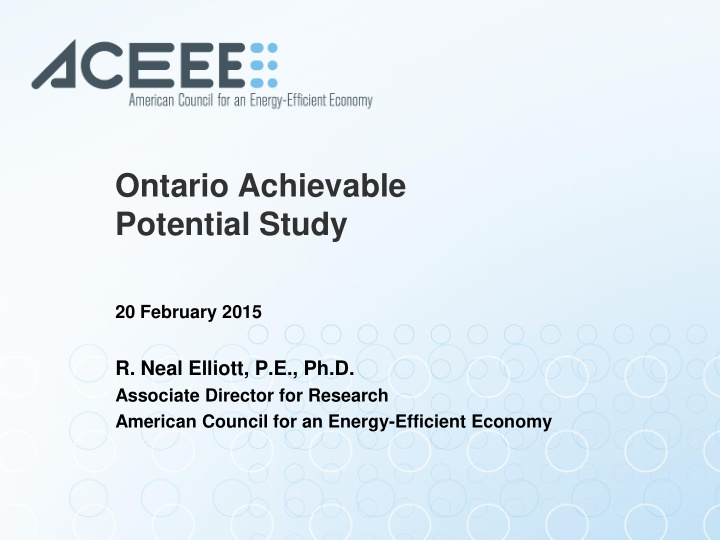



Ontario Achievable Potential Study 20 February 2015 R. Neal Elliott, P.E., Ph.D. Associate Director for Research American Council for an Energy-Efficient Economy
The American Council for an Energy- Efficient Economy (ACEEE) • ACEEE is a 501(c)(3) nonprofit that acts as a catalyst to advance energy efficiency policies, programs, technologies, investments, & behaviors • 50 staff; headquarters in Washington, D.C. • Focus on end-use efficiency in industry, buildings, & transportation • Other research in economic analysis; behavior; energy efficiency programs; & national, state, & local policy • Funding: ◦ Foundation Grants (52%) ◦ Contract Work & Gov’t. Grants (20%) ◦ Conferences & Publications (20%) ◦ Contributions & Other (8%) www.aceee.org Twitter: @ACEEEdc
Why do a potential study? • Provide analytic basis for energy efficiency as a resource • Quantify the EE resource for system planning • Identify & prioritize market sectors, EE measure opportunities • Inform development of utility savings targets • Determine funding levels for EE programs • Inform program design in order to achieve near- and long-term savings potential • Reassess energy efficiency opportunities as conditions/markets change
Different Levels of EE Studies Match the level of analysis to the needs of the stakeholders, e.g.: • Detailed utility program planning; • Province-wide achievable potential for long-term goal-setting; • Making the case for efficiency policies and programs – policy measures, consumer benefits, and jobs. Cost-Effective Resource Identify and engage all key stakeholders upfront to Policy Achievable understand goals of the study. Resource
ACEEE Shift from “Achievable” Analysis to “Policy” Analysis Link potential to set of tangible policy options. Bounded by cost-effective efficiency resource assessment (economic potential). Audience is a broad group of policymakers, advocates, utilities, etc. Stakeholders want information on costs, economic benefits, and jobs. Based on program experience elsewhere, e.g. time it takes to ramp up programs.
ACEEE Shift from “Achievable” Analysis to “Policy” Analysis Energy efficiency resource standards/targets Building energy codes and Realistic achievable enforcement potential State and local facility Maximum achievable performance contracting potential State-led financing programs Achievable potential Combined heat & power Rural and agriculture programs Water efficiency standards Enabling policies: pricing and education
Considerations for Conducting Potential Studies Source: EPA 2007
Strategic Questions • What is the desired outcome/goal? • Who is the study trying to influence? • What are the target audience’s key issues/framing? • Who can reach the target audience? And how? • What are their likely questions? • Who is the major opposition & what are their concerns/arguments? • What is the optimal timing for study release?
Lessons Learned • Reference case forecast & avoided costs are some of most contentious issues — least important to recommendations • “Every state/province/city is unique” • Regional studies often don’t carry political weight or reflect local politics • Beware of study fatigue/dueling studies • Studies have short political & practical shelf-life
Lessons Learned (Continued) • Communicate with stakeholders throughout the process: • Need to conduct follow-up policy implementation support for success • Data confusion • Focus can easily get shifted to data confusion from key issues the study is addressing • Focus on a few key, understandable messages that convey the findings • Transparency, transparency, transparency!!!
Strategies for Responding to Regional Variation One approach: • First step: detailed demographic & market characterization of all LDCs’ customers • Aggregate LDC’s with similar demographics together • Develop program portfolios for aggregated groupings & estimate potential savings
Defining “Achievable” • Balance participation rate vs. savings • Customer awareness is import program element — balance marketing vs. incentive budgets • Capture full range of EE Benefits • Look at programs by sector • Define prior conditions for sector allocation of programs • Understand unique market needs — engage customers • Cost effectiveness varies by program —don’t expect low income programs to achieve same level as large institutional program
Contact Information: R. Neal Elliott, Ph.D., P.E. Associate Director for Research ACEEE 529 14 th street NW, Suite 600 Washington, DC 20045 rnelliott@aceee.org 202-507-4009 Visit us on the Web at: www.aceee.org Follow us on Twitter at: @aceeedc
Recommend
More recommend